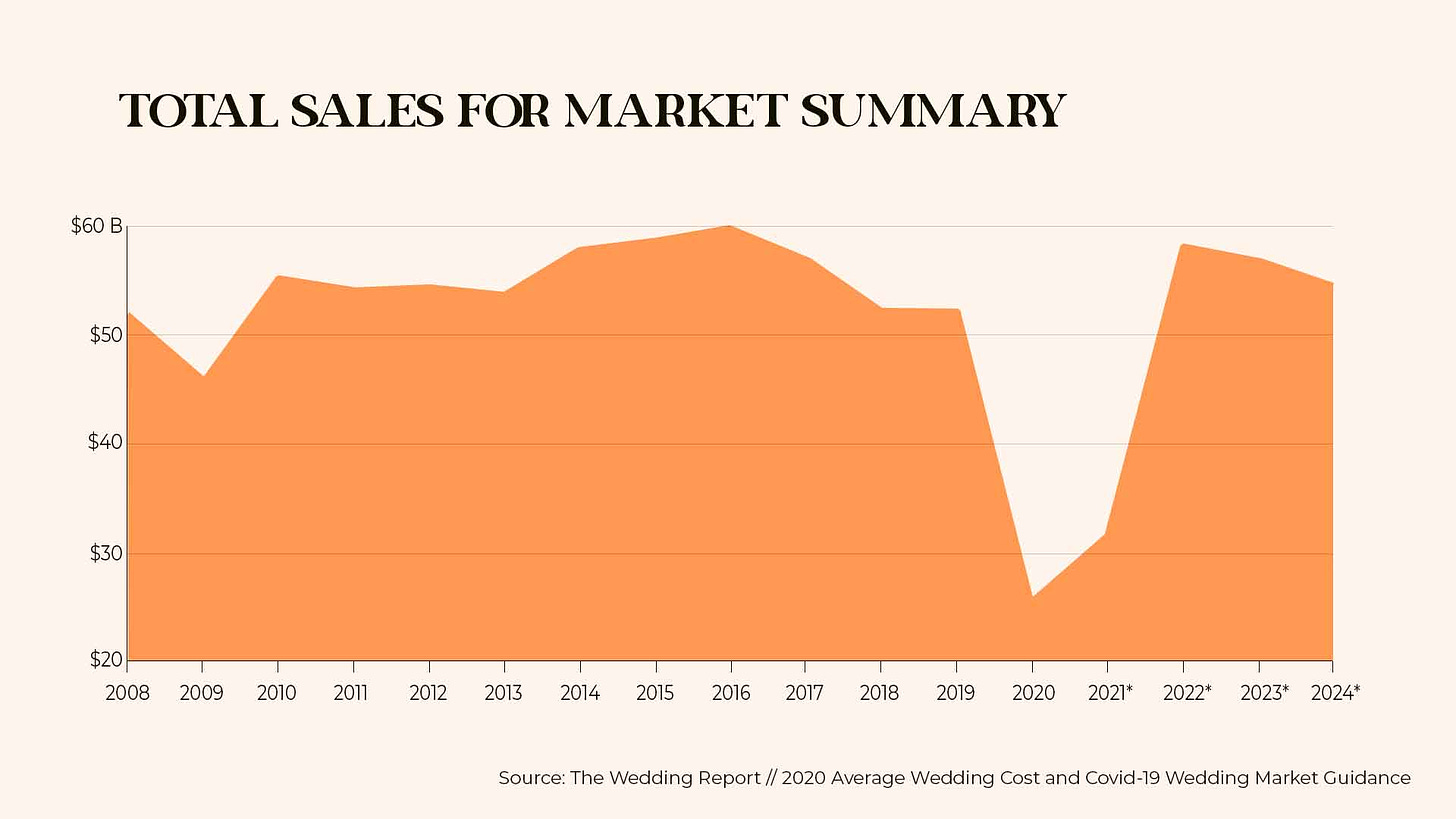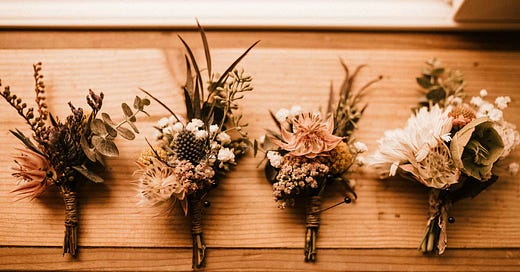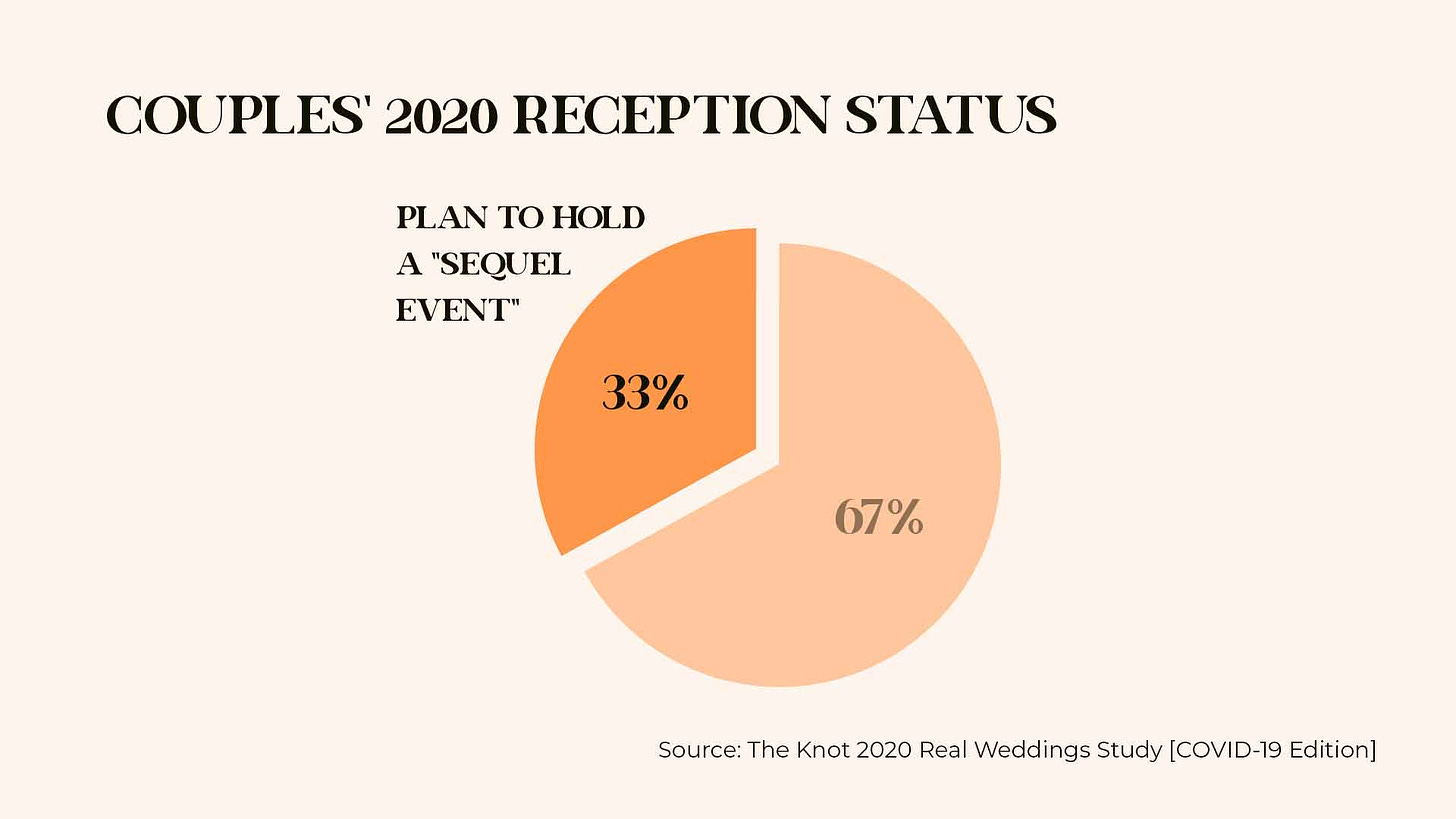💍 Your Weekly Pitch: COVID’s “sequel weddings” are saving the wedding industry
Millennials changed the economics of how weddings work
Written by @alexc_journals, a journalist who is unwittingly having a sequel wedding
A 4 minute read
FRIENDS AND FEATURES
Want to work at the New York Times? The BBC? The Washington Post? Our friends at Inside The Newsroom have you covered. They offer a resource with 2,000+ international jobs all for just $5 a month ($45/year). And because Daniel is a friend of the newsletter, Case By Case readers can email him for a free week’s trial!
Want to know how our brains work? Check out our friend Britany at One More Question who just did a profile on Case By Case! Her resource-filled newsletter gives journos a round-up of pitching opportunities (a perfect pair for our pitches!), grants, fellowships, and contests!
THE LEDE
COVID-19 tanked the wedding industry. According to experts, 2021 is anticipated to recover only because of a backlog of weddings, not because of a shift in the notoriously unchanging wedding industry.
But looking at the data, we think the experts are wrong.
The recovery will happen, but not because all weddings will go back to the way they were, with extravagant events all rolled into one.
No, the recovery will happen because there has been a fundamental genetic mutation to what a wedding is; there will be a recorvery because of the economic and staying power of sequel weddings.

COVID was the steroid that fast-tracked sequel weddings. They’re the first significant change in decades to the industry and a key consequence of our millenial cultural zeitgeist.
THE BEST PITCH
Guiding Question:
What does the increase in sequel weddings mean for the economics of the wedding industry, and what does it say about the values of the generation that embrace it?
Teaser:
As someone in the process of planning a wedding, there’s a pure practicality to sequel weddings—in fact, I just planned a sequel wedding without even realizing it.
What it is:
“Simply defined, a sequel wedding is when a couple has multiple ceremonies. Typically, the first wedding is more intimate in nature (think: a microwedding or an elopement), followed by a larger-scale second wedding, which oftentimes involves a grand reception party.”
The Knot's Esther Lee
What’s the appeal:
No need to “cram” traditions, attire, or other expectations in one day or weekend—this is especially attractive for the increasing number of interracial and intercultural couples who want to celebrate and respect each culture individually
You can celebrate twice with a more intimate group while still helping to keep your community safe through COVID
Couples spend more money per guest ($244 vs. $214) even though they used fewer vendors (12 vs. 15) and kept the wedding local more often (9% vs. 21%)
While there seems to be little data to show that sequel weddings were a thing before COVID (though there is some evidence), over a ⅓ of couples getting married in 2020 held sequel weddings—where they had their ceremony at one point, and a reception at another—both of which were small. Those events had less than 16 people invited on average.
After all, small is the new big.
This will be a huge boon for the vendors and pros of the industry
More events mean more setup like food, photography, and anything else that needs to be duplicated across events. That influx of cash in non-venue related spending will be the biggest injection of growth for new competition and offerings for couples in the future.We might see the end of the “wedding season”
Normally the wedding season is May through October, but sequel weddings in smaller spaces could mean year-round events to take advantage of off-season prices. Even though that’s cheaper for the couple, the venues still get to add to their bottom line since those spaces are more likely to be empty during the off-season.
Why sequel weddings aren’t going away
The general trend of weddings is to spend more money on fewer people because it reflects the values of couples who increasingly care about their guests' experience.
In 2009, the average wedding size was 149, with an average budget of $28,285.
Compare that to 2019, where the average wedding size was 131, with an average budget of $33,900.
Sequel weddings put the new priorities of modern couples first.
THE NEWS PEG
The 2021 and 2022 is expected to be explosive for the wedding industry because of the general wedding backlog.
If you’re pitching this story, you can’t go wrong.
Either the experts will be right, and sequel weddings are worth writing about as a contributing factor to the industry boom, or analysts will be way off the mark, in which case, sequel weddings might be the only factor worth writing about in the wedding industry as it mutates into something new.
Either way, this is a pitch worth writing about.
WHY THIS STORY IS WORTH PURSUING
Sequel weddings reflect more than just practicality and necessity in the era of COVID. They’re also the result and extension of multicultural weddings which continue to be on the rise and interracial marriage continues to grow post-Loving v. Virginia.
DIVERSE SOURCES TO INTERVIEW
Wedding planners
There’s been plenty of interviews with folks at The Knot and Zola, so we suggest getting a unique angle by speaking with a microwedding and sequel wedding planning expert like Mandy Weiss. There are also countless others you can interview as well for a comprehensive perspective.
A narrative
The narrative version of this story would follow one or more couples as they execute on their sequel wedding. Figure out what aspect of the sequel wedding made them decide it was worth doing? Was it money? Time? Mixed culture? COVID?
PUBLICATIONS TO PITCH TO
Fortune
Lifestyle desk contacts: Daniel Bentley; daniel.bentley@fortune.com, Rachel King; rachel.king@fortune.comSlate
Business desk contacts: Jonathan Fischer; jonathan.fischer@slate.comThe New York Times
Weddings and Vows contact: LeAnn Wilcox; wilcox@nytimes.com
OTHER PITCHES IN THIS SPACE
Dive into the actual term “sequel wedding.” Dozens of cultures already spread out wedding events over multiple days and even weeks, but it’s interesting that the western world is looking at sequel weddings as a new phenomenon. Is there a whitewashing to this “discovery” of a practice that has been around in non-white cultures for centuries?
To what degree did interracial marriage play in the development of sequel weddings in the first place? Little research has been done on how the phenomenon started, and we know it isn’t all due to COVID. What started the sequel wedding? Is that force enough to keep the trend afloat once COVID is long gone?
IN CASE YOU MISSED OUR LAST PITCH
Last week we covered a culture and economic story called “The power behind the stan;” a pitch on why fans are so much more than the media they love.
ADDITIONAL SOURCES
The Knot 2020 Real Weddings Study [COVID-19 Edition] | The Knot
What Weddings After COVID Will Look Like
The Sequel Wedding: What Is It and How Do I Have Two Ceremonies?
Micro Wedding vs. Minimony vs. Elopement: How to Choose
2021 WeddingWire Newlywed Report: COVID-19 EDITION
Zola's plan to take on the $72 billion wedding industry Fast Company Zola
SEE YOU ON THE WIRE
Want the next great pitch before anyone else?
Want to share this pitch with another journalist who might want to run with this story?
See something we should have added/corrected/a tip for a future story? Publishing this story and want us to share?
Have ideas on how we can improve as a service for journalists?






